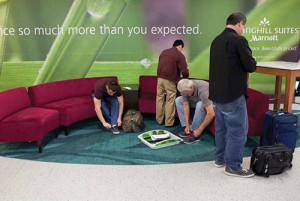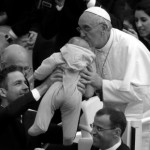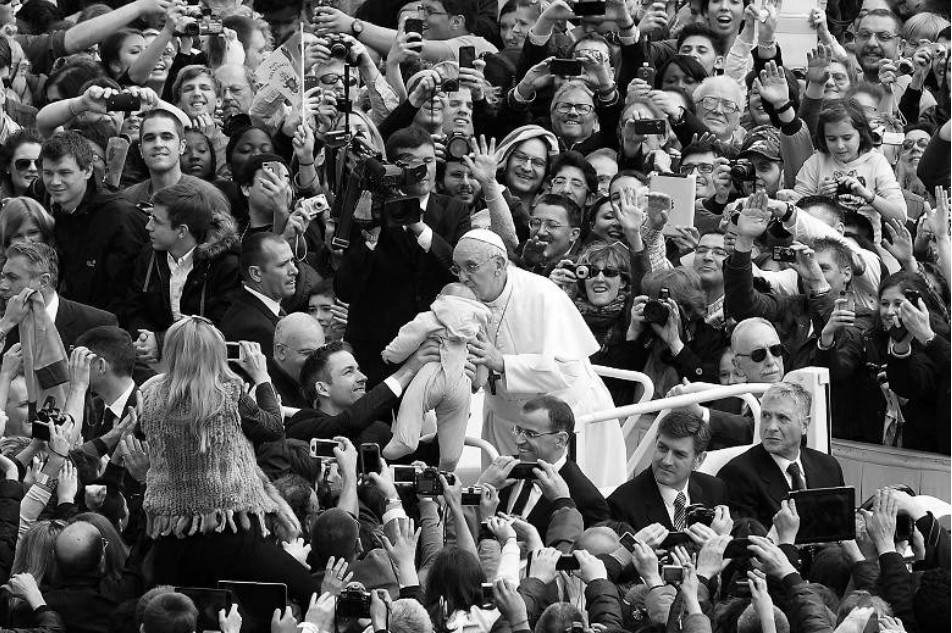Think of a time you went to an event or a place where there was a big crowd of people, more than a thousand. Maybe it was a game, a concert, a museum, or walking the streets of downtown Chicago. Think about the unposted rules and directions you follow when you’re walking in a crowd like that. Give safe space to others. Move with the group. Wait your turn. You may think walking in a crowd requires you to unconsciously obey many more rules and directions, but actually the basic rules are about three.
In 1986 Craig Reynolds developed an artificial life computer program called “boids” (for bird-oids, like an-droids) which recreated the flocking behavior of birds based on three simple rules:
- separation: steer to avoid crowding local flockmates
- alignment: steer towards the average heading of local flockmates
- cohesion: steer to move toward the average position of local flockmates
These three simple rules provide foundational behavior for much of the action in the worlds of countless video games and computer-animated movies.
If our individual movement in a crowd is so simple, why does our individual experience in crowds often come with so much stress? Think about going through airport security. Sometimes TSA personnel tell you where to go and what to do, but for the most part you flow undirected into the line to be processed and you dance the little TSA dance, hoping to get through in a timely manner. Because you took off your belt you may get through with your pants falling down and your shoes stuck in the scanner, but usually you make it through without too much fuss. For most of us, I assume, going through airport security is not relaxing or enjoyable. We have to submit ourselves to TSA scrutiny because we’re just one more individual lumped into a crowd of people, a crowd that may include a rogue person looking to do some very bad things.
I would like to suggest that our stress at the airport or in other crowds comes not from the simple rules we have to follow (rules provide order and safety, after all, and thus should provide comfort), but rather our stress comes from the dehumanizing lack of hospitality that inherently comes with being just one more person in the crowd. I’m reduced to a possible threat to the system. I’m reduced to my ID and my boarding pass. I’m reduced to a body that needs to be scanned. My possessions may be confiscated if they violate the rules. I may be barked at to “go to that line” or to “put your hands above your head.” Of course this is all a small price to pay to make everyone as safe as we can. Nevertheless, it’s a dehumanizing process with zero hospitality built in. Does airport security have to be so inhospitable?
 Not at Dallas/Fort Worth International. Marriott spent half a million dollars to upgrade (and brand) a 3,000 square-foot screening station in Terminal E that features oversized artwork, LED lighting, mood music, an improved sound system, a queue management system, new containers for passenger belongings, and a “re-composure area” with plush, hotel-style couches. One airport executive said of the remodel, “We want to welcome guests. We want them to know that we want them to be here. We need them to be here. We want them to feel comfortable and to have a good experience and good take-aways from DFW.” The emphasis then becomes welcoming passengers on their journey and not on stark treatment of persons as members of a stressed out and threatening crowd.
Not at Dallas/Fort Worth International. Marriott spent half a million dollars to upgrade (and brand) a 3,000 square-foot screening station in Terminal E that features oversized artwork, LED lighting, mood music, an improved sound system, a queue management system, new containers for passenger belongings, and a “re-composure area” with plush, hotel-style couches. One airport executive said of the remodel, “We want to welcome guests. We want them to know that we want them to be here. We need them to be here. We want them to feel comfortable and to have a good experience and good take-aways from DFW.” The emphasis then becomes welcoming passengers on their journey and not on stark treatment of persons as members of a stressed out and threatening crowd.
Now let’s jump into a time machine and go back in history 3,000 years to ancient Israel. Welcoming God’s presence amidst God’s people is the purpose of Solomon’s temple, the first temple built to house the ark of the covenant. And likewise, the purpose of the temple is to welcome God’s people into God’s presence. When we read 1 Kings 6 & 7 we encounter a detailed description of Solomon’s temple during its construction, which started 480 years after the Israelites came out of Egypt. To our modern sensibilities we may encounter chapters 6 & 7 as if they are a dry recitation of the facts on an audio tour of a museum. The purpose is, however, to portray for the reader the grandeur of God’s welcoming presence. Perhaps the most significant verses in the long description of the temple are verses 11-13 of chapter 6:
11 Now the word of the Lord came to Solomon, 12 “Concerning this house that you are building, if you will walk in my statutes, obey my ordinances, and keep all my commandments by walking in them, then I will establish my promise with you, which I made to your father David. 13 I will dwell among the children of Israel, and will not forsake my people Israel.”
In short, God says, “If you walk with me, I will walk with you.” For us as Christians, this promise from God is fulfilled in Jesus, who walked and taught among us. It’s too easy to get bogged down in reading the Bible and think it’s all about the rules and regulations. There are 613 commandments recorded in the Bible according to Jewish tradition. At least 150 of those commandments can’t be observed today because they have to do with the temple, which doesn’t exist, temple sacrifices, and the theocratic kingdom of Israel, which also doesn’t exist.
The scripture we heard this morning from 1 Kings 8 is the beginning and end of Solomon’s grand speech at the dedication of the temple. In a sense, this is a grand ribbon-cutting ceremony. A huge crowd is gathered. “The elders of Israel and all the heads of the tribes, the leaders of the ancestral houses of the Israelites” stand before King Solomon. The time is likely the festival of Booths, one of three festivals for which people made pilgrimage to Jerusalem. This festival, called Sukkot in Hebrew, commemorates the fragile dwellings the Israelites lived in during their 40 years of wandering in the wilderness after their exodus from Egypt. The part in the middle of chapter 8 we didn’t hear from Solomon’s speech lists several scenarios in which the people may find themselves “praying toward this place,” the temple, such as when foreigners come to their land. Solomon pleads to God to hear the people and meet the people through the temple. Again, this is the purpose of the temple, to be a place of mutual welcoming. In the words of Solomon: “The Lord our God be with us, as he was with our ancestors; may he not leave us or abandon us, but incline our hearts to him, to walk in all his ways … so that all the peoples of the earth may know that the Lord is God; there is no other.”
And there was considerable complaining about him among the crowds. While some were saying, “He is a good man,” others were saying, “No, he is deceiving the crowd.” – John 7:12
In the other passage, in John 7:1-18, we encounter the Son of God deeply reluctant to go to Jerusalem to celebrate the festival of the Booths. And then, in a shocking violation of our expectations of Jesus as a man of his word, Jesus goes back on his word, “I am not going to this festival, for my time has not yet fully come,” and he does go in “secret.” Can you blame Jesus for going back on his word? He was not ready to get caught up and profiled as a troublemaker, preaching the “kingdom of God,” a threat to Roman rule, in the midst of a crowd. Then the writer of John says:
The Jews were looking for him at the festival and saying, “Where is he?” And there was considerable complaining about him among the crowds. While some were saying, “He is a good man,” others were saying, “No, he is deceiving the crowd.”
We should remember that when John says, “the Jews,” he is not referring to all of the Jews as a people but rather to political leaders in cahoots with the Romans trying to maintain order in an especially rebellious time. Yet, even among the threats, Jesus found it important to join the festival crowd.
One leader plays to the crowd and excites them for celebration.
The other leader is skeptical of the crowd’s stability.
 And now let us look at the two pictures on the bulletin cover this morning. These two pictures are of the same moment in 2013 after Pope Francis officiated his first Easter service in St. Peter’s Square as pope. I do not intend to say anything about the pope or his persona or his views of relating to the crowds. Rather, I put these two pictures together to highlight the expectations we have of leaders to relate to the crowds. In the top picture we see an intimately cropped photo of Pope Francis kissing a baby handed up to him by one of his security personnel.
And now let us look at the two pictures on the bulletin cover this morning. These two pictures are of the same moment in 2013 after Pope Francis officiated his first Easter service in St. Peter’s Square as pope. I do not intend to say anything about the pope or his persona or his views of relating to the crowds. Rather, I put these two pictures together to highlight the expectations we have of leaders to relate to the crowds. In the top picture we see an intimately cropped photo of Pope Francis kissing a baby handed up to him by one of his security personnel.
 In the larger photo we see the same moment with more context, but the picture contains several people edited into the scene, people that were not even there. Look carefully over the pope’s left shoulder and you’ll see an example of this. There were a quarter million people in the square that day. There were surely hundreds of thousands of pictures taken by people that day in the crowd, and yet here is a picture edited to the Nth degree to show how the crowd exists for the crowd’s sake and not so much for the sake of the pope or for the sake of the baby or any other individual. Someone edited this photo to show us the absurdity of the crowded spectacle. The questions begs us to ask, “Is this moment about the pope’s blessing of the baby? Or is it about us as gawkers in the crowd?”
In the larger photo we see the same moment with more context, but the picture contains several people edited into the scene, people that were not even there. Look carefully over the pope’s left shoulder and you’ll see an example of this. There were a quarter million people in the square that day. There were surely hundreds of thousands of pictures taken by people that day in the crowd, and yet here is a picture edited to the Nth degree to show how the crowd exists for the crowd’s sake and not so much for the sake of the pope or for the sake of the baby or any other individual. Someone edited this photo to show us the absurdity of the crowded spectacle. The questions begs us to ask, “Is this moment about the pope’s blessing of the baby? Or is it about us as gawkers in the crowd?”
When we find ourselves in the crowd, looking for Jesus, do we focus on Jesus and what Jesus is doing, like welcoming the little children? Or do we feed off the buzz and excitement of the crowd and enjoy filling ourselves with that excitement at the expense of welcoming others? Because Solomon was king he could preach to the crowds to welcome foreigners so they “may know that the Lord is God; there is no other.” People should listen to the king. But when the true king, the Son of God, says he isn’t going to play to the crowds to seek his own glory, that he is more interested in seeking the glory of God, do we follow him and do likewise, to the glory of God? “Those who speak on their own seek their own glory; but the one who seeks the glory of him who sent him is true, and there is nothing false in him.”
When the Pharisees tested Jesus, they asked him, “Teacher, which commandment in the law is the greatest?” He said to him, “‘You shall love the Lord your God with all your heart, and with all your soul, and with all your mind.’ This is the greatest and first commandment. And a second is like it: ‘You shall love your neighbor as yourself.’ On these two commandments hang all the law and the prophets.”
Following Jesus, living the Christian life is counterintuitive. When we get caught up in the celebration of crowds or the crowd mentality through media and celebrity culture our tendency is to seek a leader who can inspire us and sustain the excitement of being in the crowd. And if the crowd may contain a threat or be unstable we seek power and control through the enforcement of rules and regulations to keep us safe. In the celebratory crowd we may seek some special status, some special position to get our baby kissed, an autograph signed, or a picture taken. In the unstable or threatening crowd we may seek special treatment that gets us through to safety. Being in the crowd has the strange effect of making us look out for ourselves as individuals to the exclusion of others, especially when the crowd goes chaotic. The crowd can be celebratory and hospitable, but it is not up to the leader; it is up to us as individuals what attitude and practice we bring to the crowd.
We would do well to follow Jesus, to discern what’s going on inside ourselves as individuals, as Jesus did with himself, when the crowds get too excited. We would do well to follow Jesus’s commandments to love God and love others. What does that look like? Well, the three simple rules as suggested by the computer engineer, Craig Reynolds, does a good job showing us: give space, move with the group, wait our turn.
Amen.



